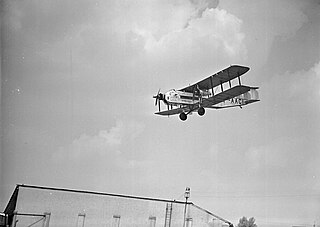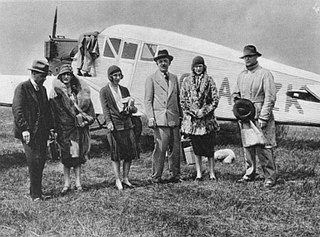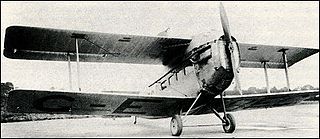
Silver City Airways was an airline based in the United Kingdom that operated mainly in Europe between 1946 and 1962. Unlike many airlines at the time, it was independent of government-owned corporations; its parent company was Zinc Corporation, an Australian company involved mainly in mining and mineral processing. The name "Silver City" originated as a nickname of Broken Hill, Australia – an area famed for silver mines, including some owned by the airline's parent company.

The Short Solent is a passenger flying boat that was produced by Short Brothers in the late 1940s. It was developed from the Short Seaford, itself a development of the Short Sunderland military flying boat design.

Portsmouth Airport, also known as Portsmouth City Airport, PWA (Portsmouth Worldwide Airport) and Hilsea Airport, was situated at the northeast Hilsea corner of Portsea Island on the south coast of England and was one of the last remaining commercial grass runway airports in the United Kingdom.

Channel Airways was a private airline formed in the United Kingdom in 1946 as East Anglian Flying Services.
British Aviation Services Limited (Britavia) was an early post-World War II airline holding company and air transport operator that could trace its roots back to 1946. Its main activities included trooping, inclusive tour (IT) and worldwide passenger and freight charter services. British Aviation Services' first investment in a British independent airline occurred in 1946, when it acquired a minority interest in Silver City Airways. Silver City Airways operated the world's first cross-Channel air ferry service on 13 July 1948. It subsequently became British Aviation Services' biggest operating division. In 1953, British Aviation Services took over the independent airline Air Kruise. The same year, BAS Group also took control of Aquila Airways, the last commercial flying boat operator in the United Kingdom. The completion of these acquisitions by mid-1954 resulted in a reorganisation of the British Aviation Services group, with British Aviation Services Ltd (BAS Group) becoming the group's holding company and Britavia one of its operating subsidiaries. By the late 1950s, BAS Group became Britain's largest independent airline operator. Its numerous operating divisions included Britavia's Hermes Division at Blackbushe Airport and Aquila Airways's Flying Boat Division at Hamble near Southampton. The former concentrated on trooping services and inclusive tours while the latter provided scheduled services to Portugal, the Canary Islands and Italy. In 1962, BAS Group merged with British United Airways (BUA), which by that time had replaced BAS as the UK's largest independent airline operator.

On 6 January 1954 WJ474 a twin-engined Vickers Valetta training aircraft of No. 2 Air Navigation School Royal Air Force crashed near RAF Bovingdon just after takeoff in bad weather.

On 28 March 1933, an Armstrong Whitworth Argosy II passenger aircraft, named City of Liverpool and operated by British airline Imperial Airways, crashed near Diksmuide, Belgium, after suffering an onboard fire; all fifteen people aboard were killed, making it the deadliest accident in the history of British civil aviation to that time. It has been suggested that this was the first airliner ever lost to sabotage, and in the immediate aftermath, suspicion centred on one passenger, Albert Voss, who seemingly jumped from the aircraft before it crashed.
The 1947 Croydon Dakota accident occurred on 25 January 1947 when a Spencer Airways Douglas C-47A Skytrain (Dakota) failed to get airborne from Croydon Airport near London, and crashed into a parked and empty ČSA Douglas C-47 destroying both aircraft and killing 11 passengers and one crew member.

The 1934 Hillman's Airways de Havilland Dragon Rapide crash occurred on 2 October 1934 when a de Havilland DH.89A Dragon Rapide of Hillman's Airways crashed into the English Channel off Folkestone, Kent, killing all seven people on board. The aircraft was operating an international scheduled passenger flight from Abridge Aerodrome to Le Bourget Airport, Paris. The accident resulted in the first write-off of a Dragon Rapide.

The 1929 Imperial Airways Handley Page W.10 crash happened on 17 June 1929 when Handley Page W.10 G-EBMT suffered an engine failure and subsequently ditched in the English Channel off Dungeness with the loss of seven lives. The aircraft was operating an international scheduled flight from Croydon to Le Bourget Airport, Paris, France.

On 19 June 1954 a Swissair Convair CV-240 ditched off Folkestone, Kent when it ran out of fuel while crossing the English Channel. All on board survived the ditching, but three people who could not swim drowned. There were no lifejackets or water safety equipment on board, as regulations did not require them on short flights over water.

The Meopham Air Disaster occurred on 21 July 1930 when a Junkers F.13ge flying from Le Touquet to Croydon with two crew and four passengers crashed near Meopham, Kent, with the loss of all on board. The report of the inquiry into the accident was made public, the first time in the United Kingdom that an accident report had been published.

The 1928 Imperial Airways Vickers Vulcan crash occurred on 13 July 1928 when a Vickers Vulcan on a test flight from Croydon Airport with a pilot and five passengers crashed near Purley, Surrey three miles from the airport, with the loss of four passengers. As a result of the crash Imperial Airways stopped the flying of staff on test flights.

The August 1923 Air Union Farman Goliath crash occurred on 27 August 1923 when a Farman F.60 Goliath of Air Union crashed at East Malling, Kent, United Kingdom following an engine failure and reported panic amongst the passengers. One person was killed and nine were injured, including celebrated French actor Jean Murat.

The 1923 Daimler Airway de Havilland DH.34 crash occurred on 14 September 1923 when a de Havilland DH.34 of Daimler Airway operating a scheduled domestic passenger flight from Croydon to Manchester crashed at Ivinghoe, Buckinghamshire, England, killing all five people on board.

The 1924 Imperial Airways de Havilland DH.34 crash occurred on 24 December 1924 when de Havilland DH.34 G-EBBX of Imperial Airways crashed at Purley, Surrey, United Kingdom killing all eight people on board. The aircraft was operating a scheduled international flight from Croydon, Surrey, to Paris, France. It was the first fatal accident suffered by Imperial Airways and led to the first public inquiry into a civil aviation accident in the United Kingdom. As a result of issues brought up during the inquiry, Croydon Airport was expanded, absorbing most of Beddington Aerodrome.

On 29 September 1934, an Airspeed Courier of London, Scottish & Provincial Airways Ltd crashed just north of Shoreham, Kent. The aircraft was on a scheduled international passenger flight from Heston Aerodrome west of London to Le Bourget Airport, Paris. All four people on board were killed. Two people were injured by flying debris.

The 1912 Brooklands Flanders Monoplane crash was the first aviation accident in which an investigation was made into the cause of the accident and a report subsequently published, thus marking the start of aviation accident investigation worldwide. A Flanders F.3 Monoplane crashed at Brooklands, Surrey, United Kingdom, killing the pilot and his passenger. The cause was determined to be pilot error.















